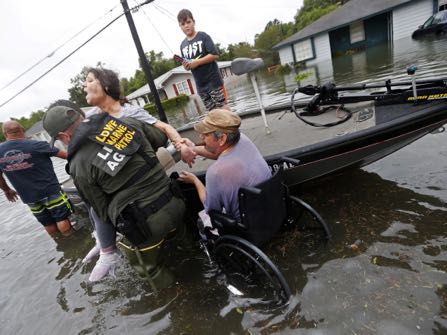Hurricane Harvey Turns News Reporters Into Rescuers

NEW YORK (AP) — In the midst of documenting the flooding in Texas, several news reporters have set aside their roles as observers to help people in danger.
They’ve lifted people into boats, connected families through social media, flagged down rescuers and, in one case, coaxed people out of a flooding apartment house while on television. Most news reporters try to stay out of their stories, but say the dire situations they’ve seen because of Hurricane Harvey and its remnants left them no choice.
“I’m a journalist, but I’m also a human being,” said David Begnaud, a CBS News reporter who guided residents out of a flooded house in western Houston to a rescue boat in which he’d been riding. Cameras recorded the scene live on the CBSN digital stream.
While on a live shot in western Houston Tuesday, The Weather Channel’s Jim Cantore was approached by a man who was waiting for his daughter’s family to be evacuated from a nearby apartment complex. When rescuers arrived, Cantore helped deliver their message on television that everyone should leave because they may not get another chance. About 60 people eventually left, some telling Cantore they had been watching him on TV, he said.
Cantore and rescuers lifted a man in casts from two knee operations into the back of the network’s SUV and drove him to higher ground. Similarly, TWC colleague Mike Bettes was seen on the air cradling a crying baby in his arms, one of a family of five evacuees he helped transfer from a boat to a flatbed truck he’d been using to report from.
“I learned this 12 years ago to the date with Katrina’s landfall,” Cantore said Wednesday. “When people are in trouble, you just do what you can to help. I could give a crap about TV at that point.”
There are several reasons for reporters to stay out of stories, said Kelly McBride, vice president at the Poynter Institute, a journalists’ think tank. It can change the relationship they have with sources, making them feel beholden to the reporter, she said. A reporter’s job is to inform, and “any time you spend your energy on helping someone, that is energy and resources not spent on telling the story to the audience,” she said.
That said, McBride empathizes with reporters covering crises. “You can’t divorce yourself from your obligation as a human being,” she said.
Where she becomes uncomfortable is when she sees a reporter’s actions getting attention on par with the flood victims. That’s happened with Harvey, she said, declining to cite specific examples.
CBS’ Begnaud said he’s been thanked several times by Texas residents grateful that journalists are there to tell their story. That’s not always the case; CNN reporter Rosa Flores was cursed out on live television Tuesday by one victim not interested in being interviewed about her experience.
CBS News reported on the story of Brandi Smith, a reporter from the network’s KHOU-TV affiliate in Houston, who reported live from a highway overpass when her station’s studio flooded and lost power. On the road below, she spotted a truck driver with a rig caught in swirling water, and she urged him to stay put. She ran onto the highway to flag down some passing rescuers, who stopped and were able to pluck the driver to safety.
Afterward, Smith greeted the driver while still on camera.
“This is going to sound weird,” she said. “But can I hug you?”
Veteran CNN reporter Ed Lavandera, his producer and cameraman were riding in the boat of volunteer Austin Seth in Dickinson, Texas, when they heard a woman’s voice call out. They helped rescue the woman, along with her elderly father and mother. Cameras captured Lavandera helping to lift the man into the boat.
“I tend to view myself as an observer,” Lavandera said. “But in that particular situation there’s only one choice, making sure these people get out of there as quickly as possible.”
Recognizing it was only by chance that the woman was rescued by a boat with a CNN crew, Lavandera asked if she wanted to be interviewed on camera, a situation complicated by her mother suffering from Alzheimer’s disease. The woman agreed to talk, and Lavandera said he later heard from grateful relatives of the family who watched the rescue on TV.
Fox News reporter Matt Finn, who was stationed at a busy rescue scene in Port Arthur, Texas, on Wednesday, was interrupted during a live shot by a struggling woman lugging a television set. He motioned the camera away and helped her when his report ended. Similarly, he said he gave a ride to exhausted firefighters but didn’t include that detail in his reporting.
“I’m not making myself the story and I’m not a hero,” he said. “The people I’m looking at right now — the police officers and the firefighters — are the heroes.”
Yet at a time that journalists are held in low esteem, even derided as enemies of the people, instances where reporters are seen helping the public can be valuable public relations tools. Reporter rescues have been repeated on the air more than once, and network web sites have highlighted acts of their reporters. Lavandera, whose network is one of President Donald Trump’s chief targets, said he’s not into it to change people’s minds about journalists.
“I get it,” he said. “I understand that’s out there. I’m of the belief that it’s not for me to get into as a journalist. Over time, not just CNN’s work but all journalists’ work, will stand the test of time.”
Like BlackAmericaWeb.com on Facebook. Follow us on Twitter and Instagram
Share your email below to receive our daily newsletter!














